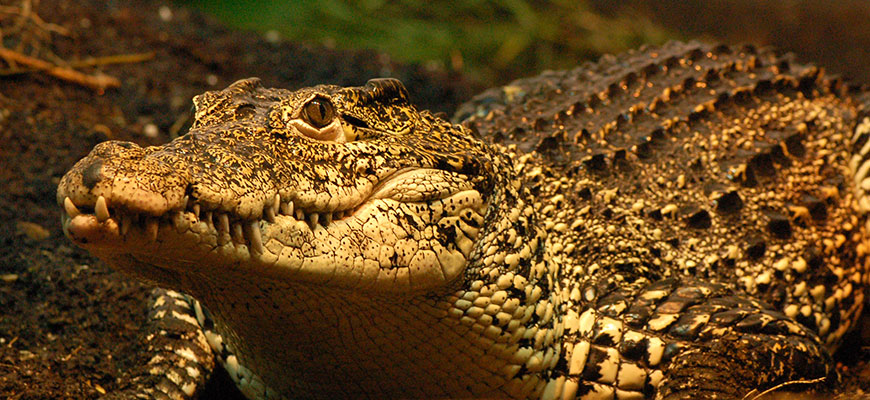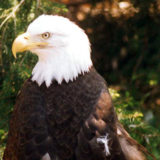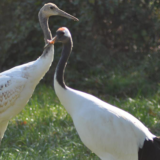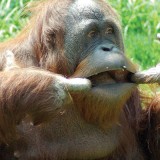RANGE:
Historically Cuba, the Cayman Islands and Bahamas. Now can only be found in two swamps in Cuba, Zapata and Lanier.
HABITAT:
Freshwater marsh and swamp.
SIZE:
Length: Male – 11 feet, Female – 8 feet
Weight: Male – 400 lbs, Female – 150 lbs
LIFE EXPECTANCY:
Can exceed 50 years.
REPRODUCTION:
A female Cuban crocodile makes a nest by scraping vegetation and soil into a mound in which she will lay 10 – 40 eggs. The female will then guard the nest from predators and will uncover the eggs when she hears the hatchlings calling. The eggs have hard shells and are about 3 inches long. They will hatch in about three months.
Crocodilians are the only reptiles that care for their young. Baby crocodiles are about 11 inches after hatching and have an “egg tooth” on the tip of their nose that will help them break out of their eggs. The “egg tooth” will fall off soon after hatching. If the babies need additional assistance hatching, the female will crack the eggs in her mouth. Young crocodiles have many enemies, like herons, and will spend 2 to 3 years in hiding until they grow large enough to protect themselves.
DIET:
Wild: Juveniles will capture arthropods and small vertebrates. Adults will eat almost any other animal they can overpower such as hutia, birds, fish and turtles.
Zoo: Rats.
BEHAVIOR:
When hunting, crocodiles sneak up on their prey by drifting on the surface of the water with only their eyes and nostrils above water. Once they have caught their prey they will drag it under water. To prevent water from entering their lungs crocodilians have a muscular flap that will close off their throat while catching and swallowing prey.
Crocodiles cannot chew their food and must swallow their prey whole or tear it into pieces and swallow. Crocodilians are amphibious reptiles and use their tail to guide and push themselves through the water. They control their body temperature by thermoregulation and spend most of the night in the water where it is warmer.
At dawn, when the water cools down the crocodile climbs onto land and lays in the sun. When it is hot a crocodile can cool off by holding its mouth open. The evaporation of the moisture in the crocodile’s mouth cools the body. In captivity Cuban crocodiles maintain dominance hierarchies based on size, gender
and temperament.
POINTS OF INTEREST:
The Cuban crocodile is a very distinctive crocodile with big teeth and heavy armor with a speckled pattern. To protect its eyes, crocodiles have a third eyelid called a nictitating membrane that covers the eye from side to side and is clear allowing the crocodile to see. Crocodilians are the largest and most highly developed of modern reptiles. “Squamosals” (bony plates) found behind the eyes on top of the head, are more prounounced in the Cuban crocodile than any other living crocodilian.
STATUS:
Critically Endangered. The Cuban crocodile has the smallest geographic distribution of any living crocodilian. Problems that threaten the Cuban crocodile are hybridization with the American crocodile, habitat destruction for agriculture and charcoal burning industries and hunting.
The AZA has established a Species Survival Plan (SSP) for the Cuban crocodile and is working to maintain the genetic diversity of the species and help conserve wild populations. The Louisville Zoo manages this program which is working to maintain the genetic diversity of the species. The Louisville Zoo manages this program for the long term survival of the species. It is estimated that there are 3,000 in the wild and 1,000 in captivity.
Cuba’s conservation agency the Empresa Nacional para la Proteccion de la Flora y la Fauna has begun a reintroduction program for the Cuban crocodile in the Lanier swamp on the Isle of Youth. To date, more,than 600 Cuban crocodiles have been released.
REFERENCES:
Bill McMahan.
AZA SSP fact sheet on the Cuban crocodile.






